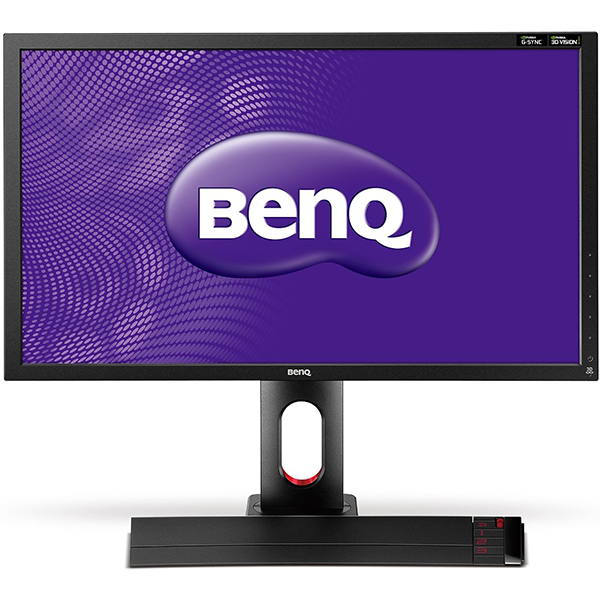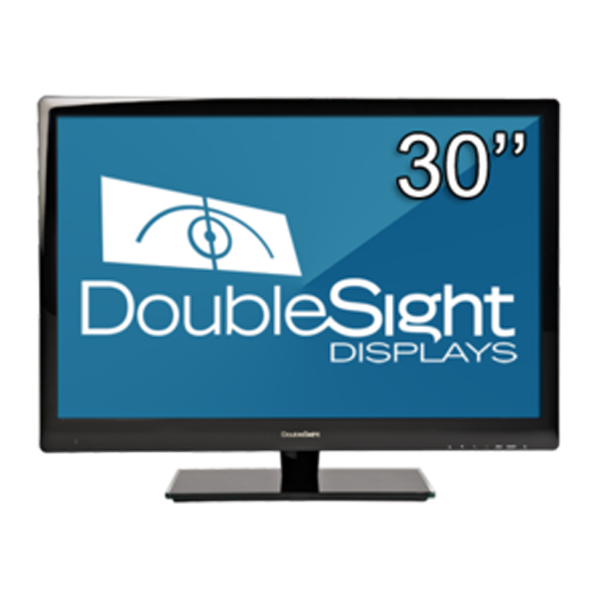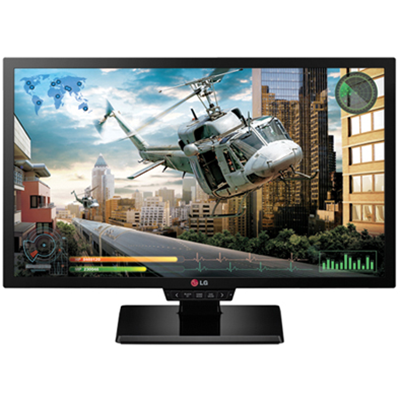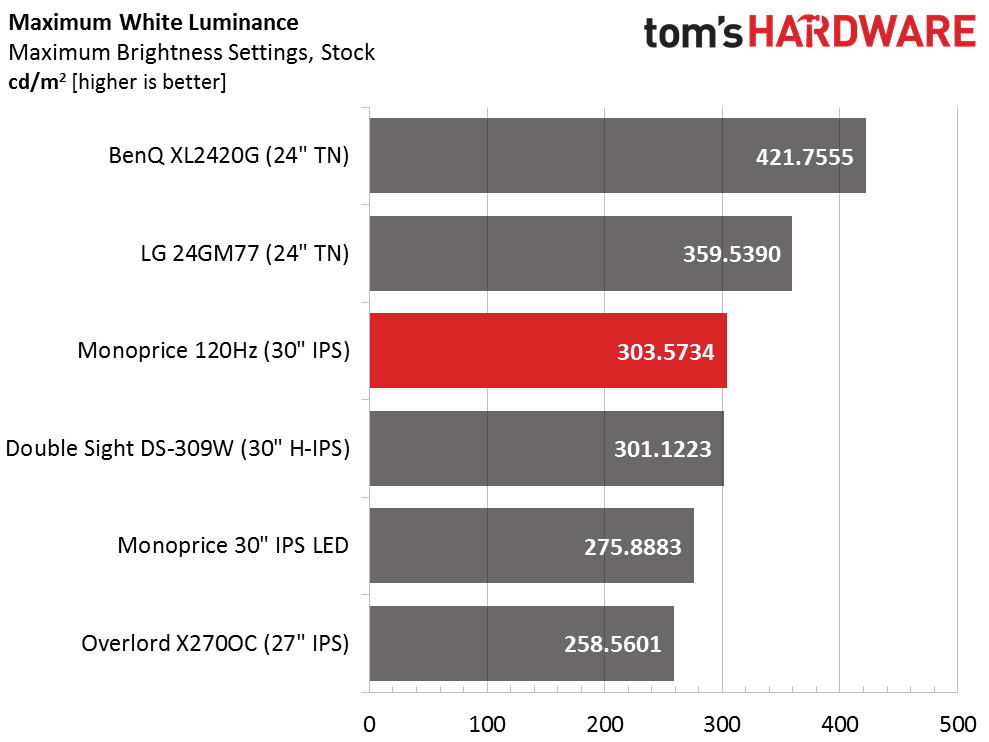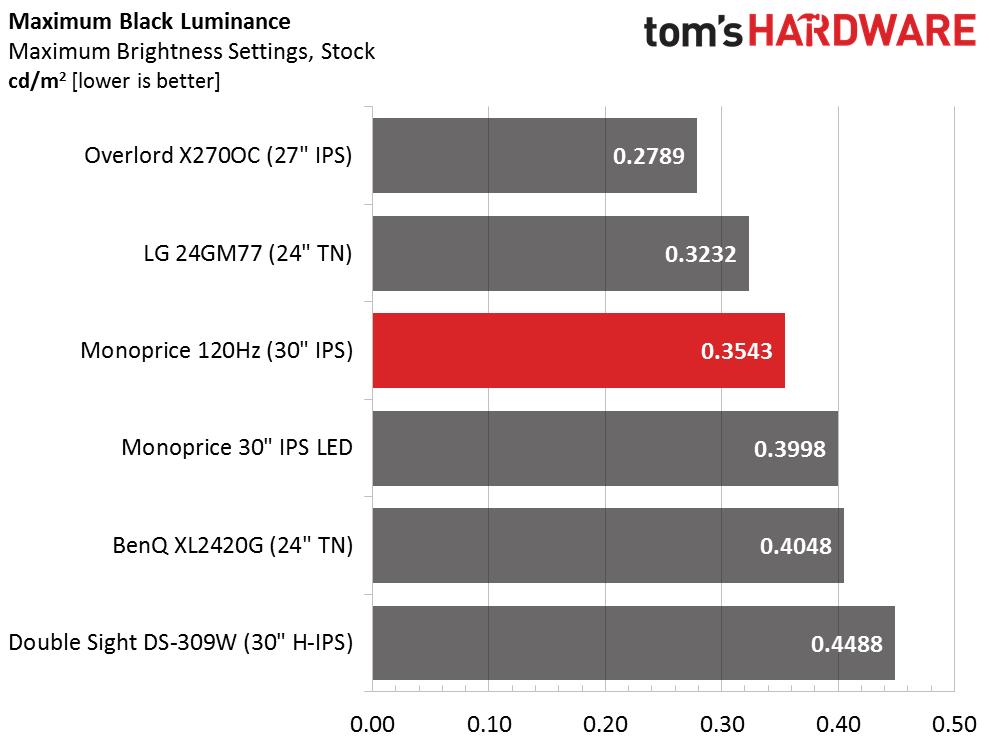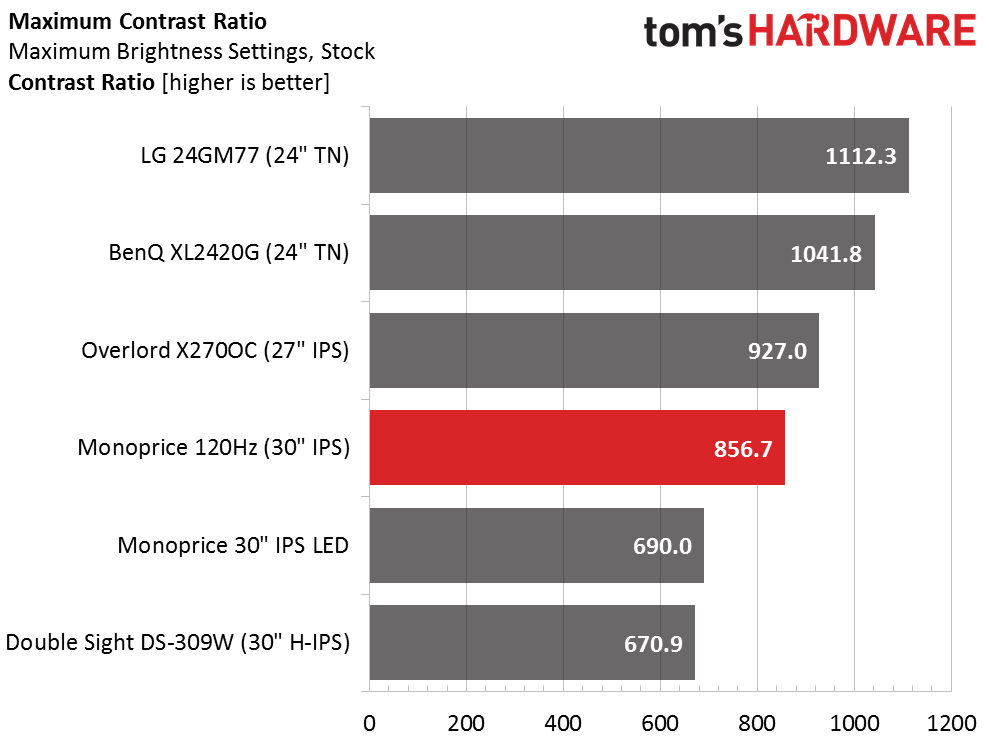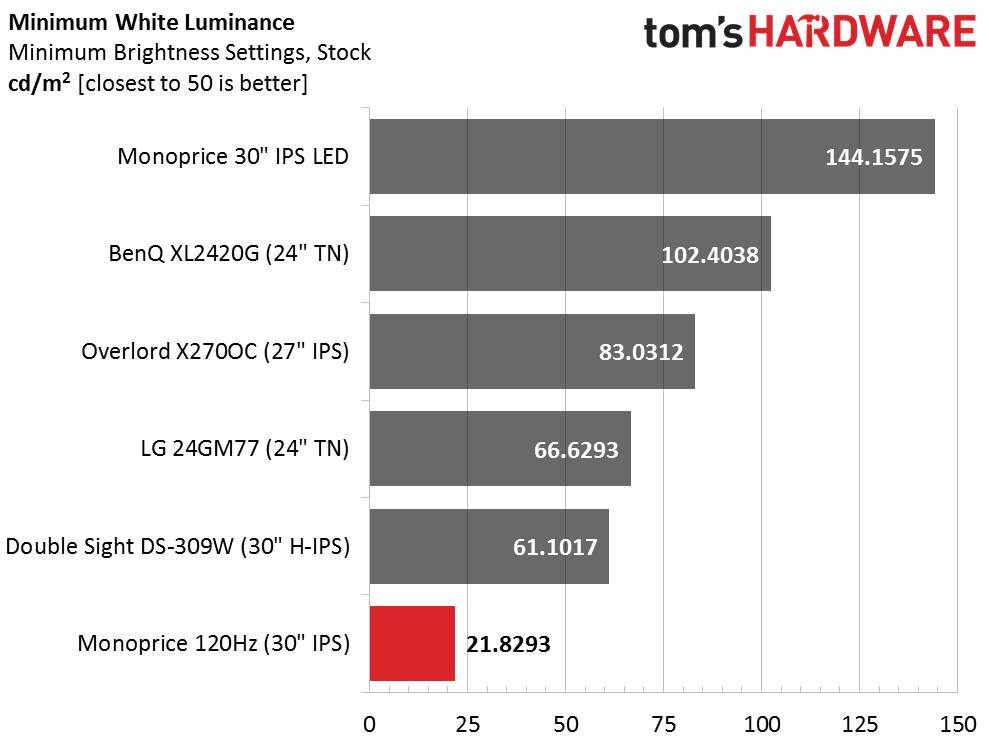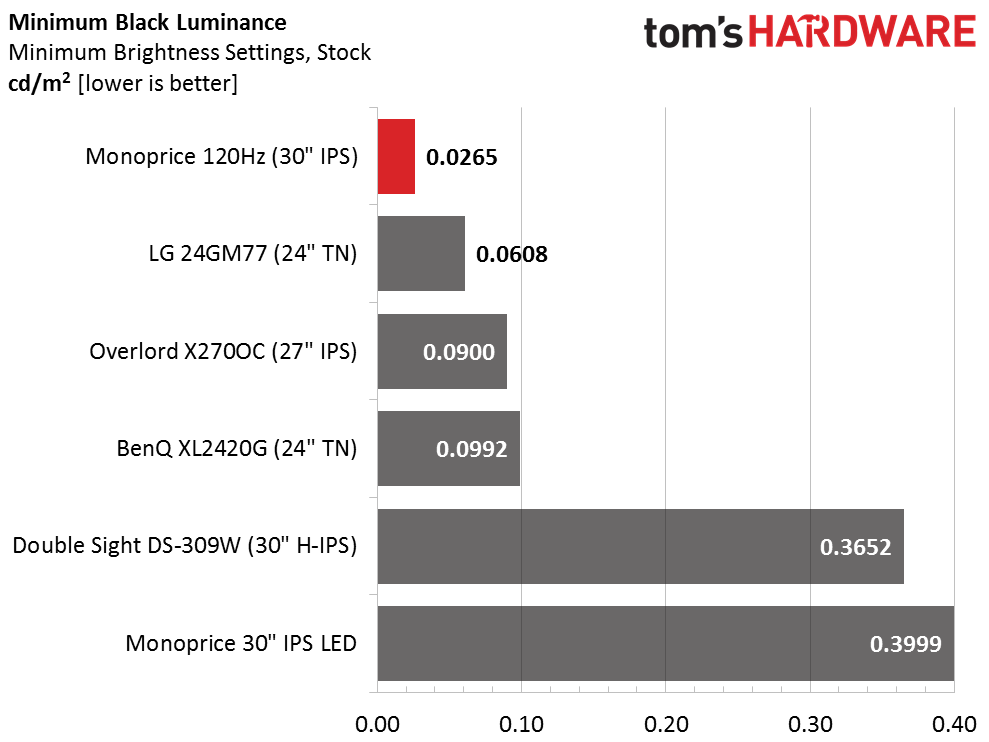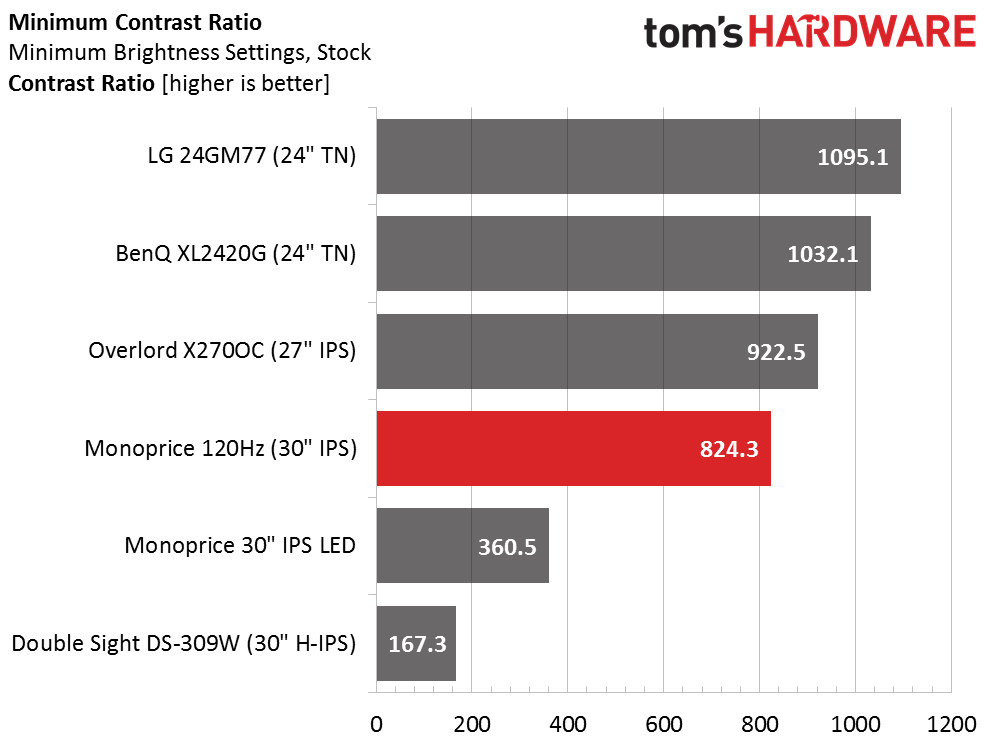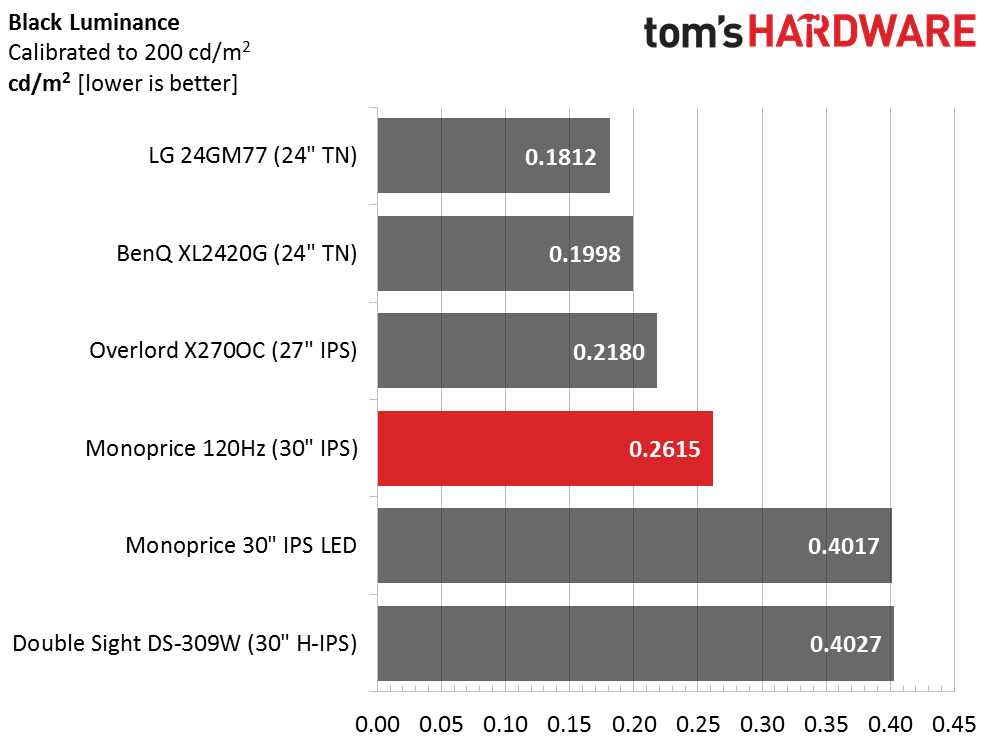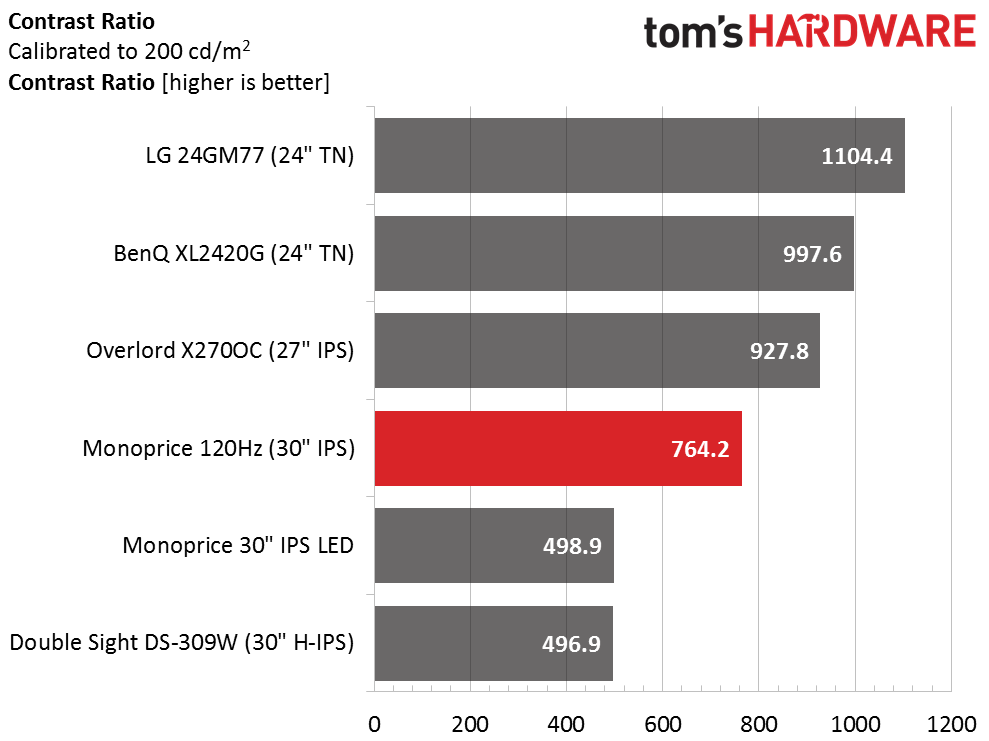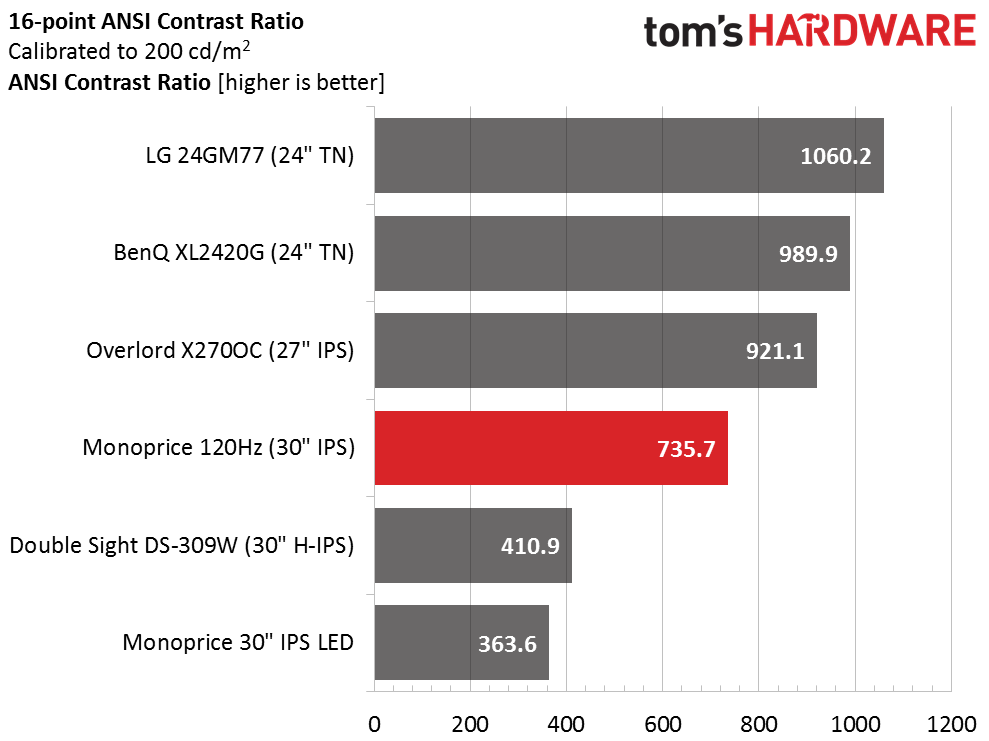Monoprice G-Pro 30-Inch 120Hz IPS Gaming Monitor Review
So far we’ve only had the chance to test one 120Hz IPS monitor, Overlord’s X270OC. Now Monoprice has brought its G-Pro 120Hz 30-inch 16:10 screen to the fast IPS party. Today we see how it performs in our benchmark suite.
Why you can trust Tom's Hardware
Results: Brightness And Contrast
To read about our monitor tests in-depth, please check out Display Testing Explained: How We Test Monitors and TVs. Brightness and Contrast testing is covered on page two.
Uncalibrated – Maximum Backlight Level
Since the G-Pro 120Hz covers multiple segments (jumbo, gaming and wide-gamut), we’re including a broader mix in today’s comparison group. We have the recently-reviewed 30” IPS-LED screen from Monoprice along with the DoubleSight DS-309W 30-inch. Both are 16:10 with wide-gamut color. Also in the mix is Overlord's Tempest X270OC, the only other fast-refresh IPS display we’ve tested. Rounding out the field are two purpose-built gaming displays: BenQ’s G-Sync-capable XL2420G and LG’s 144Hz 24GM77.
Monoprice rates the G-Pro at 350cd/m2 but our sample measures slightly over 300. This isn’t a deal-breaker unless you really need a lot of output. There is no motion-blur reduction option to dim the picture, so the extra light probably isn’t necessary in most applications.
A max black level of .3543cd/m2 is an average result, putting the G-Pro mid-pack. The Overlord is on top due to its dimmer backlight and slightly higher overall contrast.
We’d like to see a little more contrast in a gaming monitor. This result does tell us that Monoprice is using a higher-quality panel for its 30-inch gaming screen though. Considering the G-Pro’s price premium, that’s a good thing. But for IPS fans, the Overlord 27-inch display provides slightly better contrast and black levels.
Uncalibrated – Minimum Backlight Level
The backlight control takes the image down to a level that's too dark for our tastes. Remember that the brightness slider works backwards; you have to lower it to raise output. To see 50cd/m2, set it on 90.
A dim backlight always produces great black levels. If you can deal with a fairly dark image, you’ll be rewarded with deep blacks and great shadow detail. It’ll just be difficult to see.
Get Tom's Hardware's best news and in-depth reviews, straight to your inbox.
Contrast stays pretty consistent throughout the backlight’s range, with only a four-percent drop from maximum to minimum. This means the brightness control is correctly modulating the backlight and not affecting other image parameters.
After Calibration to 200cd/m2
The calibrated black level is also mid-pack. You can see that the two TN screens offer the best contrast, followed closely by the Overlord X270OC. You’re not giving up too much performance by going with the jumbo G-Pro display, though.
The final number takes a small hit because we had to lower the contrast control one click to tighten up grayscale accuracy. It represents a 10-percent drop from the max result. That's not too bad; it's still comparable to the competition, blowing away the other two 30-inch monitors.
ANSI Contrast Ratio
Given our contrast results so far, the ANSI test looks pretty good. If not for a hotspot in the lower-right corner, it would be even better. We’re still satisfied with the quality of this LG-based panel, and feel it has solid image quality and provides a good sense of depth.
Current page: Results: Brightness And Contrast
Prev Page 120Hz Setup, OSD Tour And Calibration Next Page Results: Grayscale Tracking And Gamma Response
Christian Eberle is a Contributing Editor for Tom's Hardware US. He's a veteran reviewer of A/V equipment, specializing in monitors. Christian began his obsession with tech when he built his first PC in 1991, a 286 running DOS 3.0 at a blazing 12MHz. In 2006, he undertook training from the Imaging Science Foundation in video calibration and testing and thus started a passion for precise imaging that persists to this day. He is also a professional musician with a degree from the New England Conservatory as a classical bassoonist which he used to good effect as a performer with the West Point Army Band from 1987 to 2013. He enjoys watching movies and listening to high-end audio in his custom-built home theater and can be seen riding trails near his home on a race-ready ICE VTX recumbent trike. Christian enjoys the endless summer in Florida where he lives with his wife and Chihuahua and plays with orchestras around the state.
-
kyuuketsuki Generally a Monoprice fan, but the frame-skipping makes this monitor pretty unappealing for its intended market. Hopefully they can fix it with a firmware update.Reply -
blackmagnum Monoprice is such a cheap-skate name. Why not chose a brandname less price concious like Lemon or something?Reply -
MonsterCookie I think this FINALLY is a step in the RIGHT direction. Sadly you cannot buy this in Europe.Reply
I was long ago looking for a 2560x1600 screen, and I got a Dell second-hand, because for whatever reason manufacturers ignore the customers, and they
stick to 1080p. No offense to anybody who plays at 1080p, but you need to understand, that most people do productivity and game when they have too much free time, and they want to immerse into the game on a large screen.
Personally I still love older games (Wolfenstein, FC1, Half-Life etc.) more than newer releases, and those run on these resolutions at any half-decent video card.
Furthermore, nowadays even a 500Euro *MOBILE PHONE* can do above 1080p resolution on a tiny 6" screen, and for that money they give you 32-64GB of flash, 1GB of RAM and a quad-core CPU in a tiny box.
Thus, I do not buy into this 1080p-1440p crap screen manufacturers are trying to shovel down at our throats for 1000Euros. -
danlw At this point, I think an IPS gaming monitor is like SATAe... A technology that can be skipped because something better exists. Give me an OLED gaming monitor. LG makes a 55" 1080p OLED TV for $2000... why not a 24"-ish OLED monitor for under $1000? You'd have a ginormous color gamut, infinite contrast, true black, and response times <1ms. It's time for somebody to come out with an OLED monitor that doesn't cost $5500! (Sony PVMA250)Reply -
MasterMace I'm more of the type of consumer that likes products to work as advertised out of the box - i.e. 120hz IPS 1080p out of the box. I don't want to have to "overclock" it to its advertized settings, and then have it not work on the advertised ports.Reply
Any overclocking I do personally shouldn't be advertised on the box. -
toddybody Cool Specs, and I really dig the larger panel sizeReply
...that said, after using G-Sync for 6 months now I'm scratching my head as to why any manufacturer would make a gaming panel without G-Sync or Free Sync in it.
Refresh induced stuttering and frame tearing shouldn't be acceptable in 2015 -
soldier44 Been gaming on a HP 30 inch IPS now for 5 years at 60hz. Its been worth every penny for $1200. I would steer clear of this off brand monitor regardless of 120 hz.Reply -
Eggz Close, but no cigar, MonoPrice. Looks like the Acer Predator XB270HU stays on top for now.Reply
